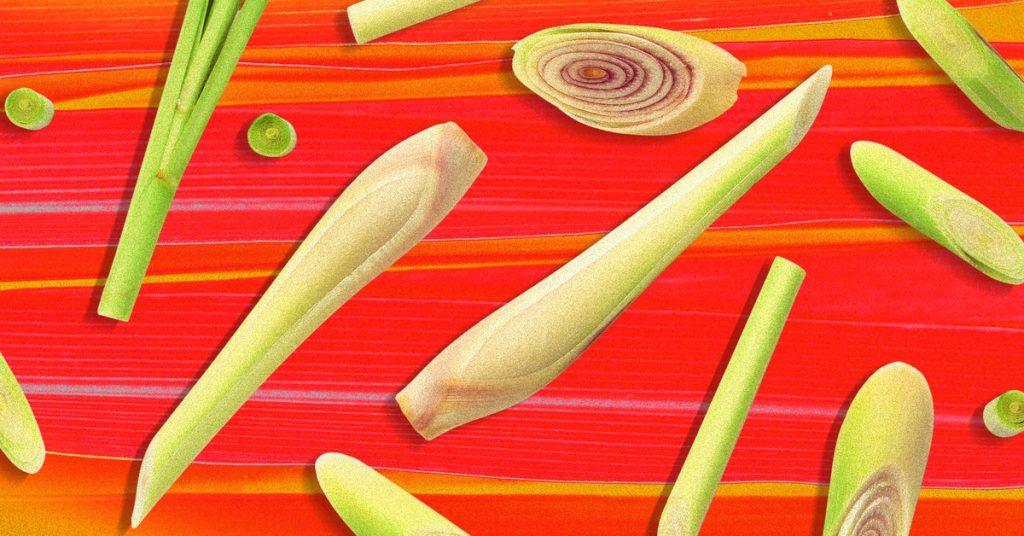In warm climates with plenty of sun, lemongrass grows like a weed. Such is the case in my mom’s backyard in Los Angeles, where the bushy tropical grass stands over three feet tall. If you find yourself in this scenario, with an armful of fragrant lemongrass, you might ask yourself, “What can I do with all of this?” The answer, it turns out, is plenty of things.
Consider Lao’d Bar in Austin, Texas, where lemongrass makes its way into both the dining room and the drinks menu. “I can’t use enough of it at our restaurant,” says chef Bob Somsith, noting that lemongrass is in his recipes for ceviche, lahb, chicken curry, sausages, and even sprinkled over his chicken wings in powder form. The yum chelada, Somsith’s riff on a michelada, is made with a concentrated tom yum broth that features plenty of lemongrass and Thai chiles that all meld together when topped with a light lager.
“Lemongrass provides very citrus-forward notes and spicy notes,” Somsith explains. “If you’ve ever pounded lemongrass and eaten as it is, it’s spicy!” Somsith recalls lemongrass growing in the backyard of his childhood home, where his family would thinly slice it and add it to jeows, a broad genre of Lao dips, that they’d eat with raw vegetables and sticky rice. Although lemongrass can be enjoyed this way when it’s properly prepared and thinly sliced, it is also often used as a flavoring agent and not meant to be chewed.
“If you don’t slice it properly, it’s very fibrous and chewy,” Somsith says. Larger chunks of pounded lemongrass can be used in soups, curries, or marinades, and are intended to impart flavor rather than be consumed. This is typically seen in soups like tom yum and tom kha, or curries like gaeng phet. Lemongrass, when simmered in a curry or soup long enough, packs a punch — but again, it isn’t for eating when it’s used this way. “We had a customer complain that our lemongrass is undercooked in our curry, so there’s still a lot of educating to do,” Somsith adds.
If you have too much lemongrass to use all at once, there are ways to preserve it without compromising its flavor. “I’ll actually put it in my food processor, grind it down, and just freeze bags and bags of it and save it for whatever I need, especially when we’re making sausages,” Somsith says. “The flavor doesn’t go away too drastically.” Fine, shredded lemongrass is perfect for incorporating into dipping sauces, salad dressings, marinades, and even salads.
You can also dehydrate lemongrass. That’s exactly what Thao Bui does for her Vietnamese herbs brand Vân Vân. “[Dehydrating] is how we keep the flavors and color intact,” Bui says, noting there is no heat involved in her company’s dehydration process. Dehydrated lemongrass can be added to soups and broths right away. “It blooms really quickly,” Bui says. For grill-related applications, like marinades, Bui suggests using a low temperature when you begin grilling, as dehydrated lemongrass may burn otherwise.
You can also turn dehydrated lemongrass into a powder, either by pounding it finely with a mortar and pestle or throwing it into a food processor. The powder is perfect for seasoning proteins before they’re fired, or for finishing a dish, as Somsith does with his chicken wings at Lao’d Bar. If you don’t like navigating the tougher pieces of lemongrass, this method provides that signature zesty flavor without requiring the use of whole stalks.
Beyond the yum chelada, you can include lemongrass in cocktails by incorporating it into a syrup. “I use one part water and one part sugar with lemongrass and let that syrup soak overnight,” Bui explains. “You can use the syrup for cocktails and mocktails,” she adds, or simply pair it with sparkling water for a refreshing and aromatic sip. For something even easier, infuse your favorite vodka or gin by adding stalks of lemongrass. If you don’t want to prepare a syrup, lemongrass is also regularly enjoyed as tea throughout Southeast Asia. To do this at home, simply steep lemongrass in hot water (a squeeze of lemon or teaspoon of honey can be added, too).
Dessert is another way to use lemongrass. Although the plant’s zestiness might seem too intense to use in a sweeter application, its citrus notes pair beautifully with simmered milk to make ice cream. “I also have a friend who made a lemon bar with lemongrass in the crust and custard,” Bui says. Lemongrass can provide complexity to any sort of citrus dessert — tarts, cakes, sorbets, and pies can all benefit from a hit.
And if you want to grow your own lemongrass, there are some added benefits, too. “I like growing a lot of lemongrass around our bar because it helps keep mosquitoes away,” Somsith says. Because it contains citronella, lemongrass is known for being a natural mosquito repellent — and other pest repellent, too. “It also keeps the deer out of your garden,” Somsith explains, noting the tropical grass helps to protect his vegetables from thieving creatures.
In other words, lemongrass can do it all. Just ask my mom, who is pounding out a fresh curry paste with it as I write.








